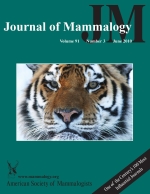Using genetic analyses, researchers have reported multiple paternity in many mammals, including ground-dwelling sciurids. Within the marmots, however, genetic mating systems have been described for relatively few species, and multiple paternity has been documented only in alpine marmots (Marmota marmota), a highly social, cooperative breeder. We used microsatellite markers to examine paternity and to describe the mating system of woodchucks (M. monax), whose social organization lies at the opposite end of the continuum from alpine marmots. We could assign paternity to 55% of juveniles. Multiple paternity occurred in 63% of litters, with up to 4 males siring offspring within a litter. Mates generally were not closely related, although relatedness calculations suggested that some pairs included close kin. Females and their mates typically lived near each other and shared portions of their home ranges. Overall, woodchucks in this natural population could be classified as genetically promiscuous. Both males and females can benefit from acquiring additional mates; however, the benefits of multiple female mating deserve further study.
How to translate text using browser tools
16 June 2010
Mating system and paternity in woodchucks (Marmota monax)
Christine R. Maher,
Melissa Duron
ACCESS THE FULL ARTICLE

Journal of Mammalogy
Vol. 91 • No. 3
June 2010
Vol. 91 • No. 3
June 2010
Marmota monax
mating system
microsatellites
paternity
woodchucks




